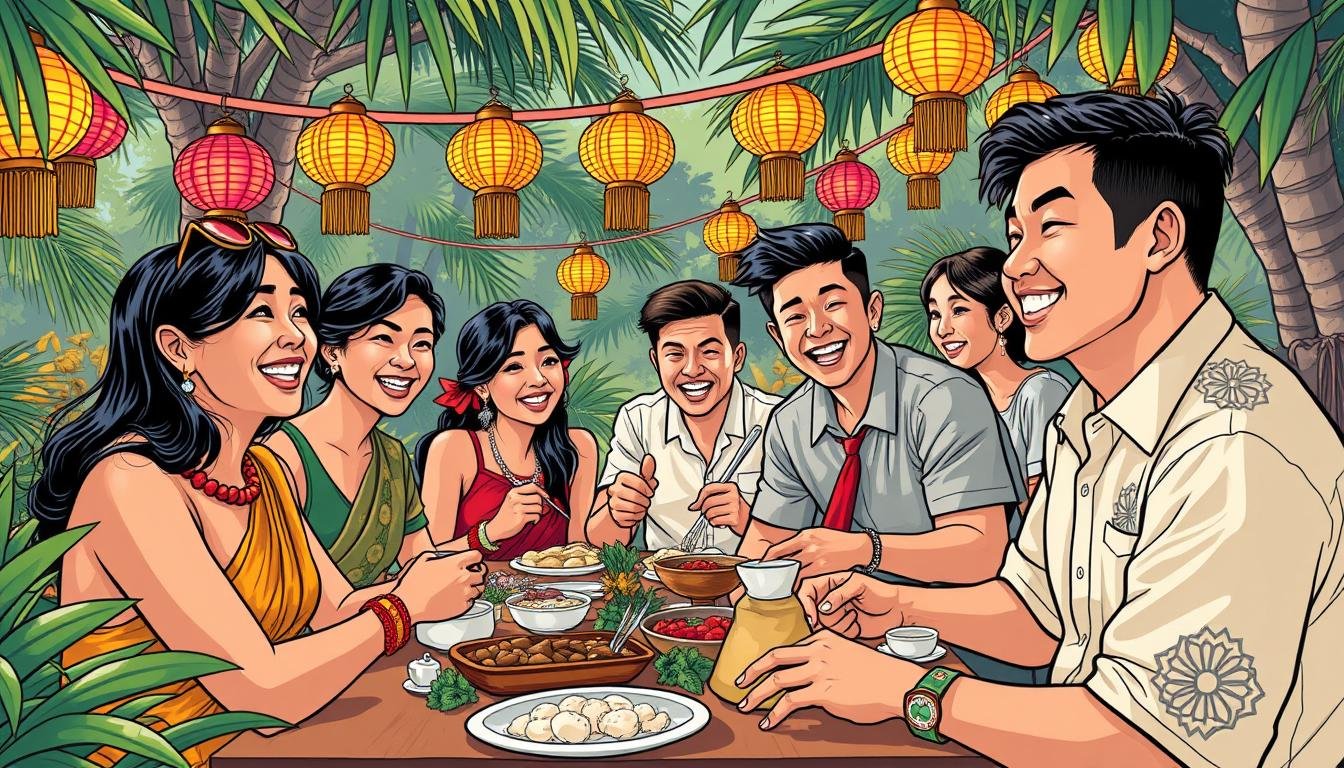What does it mean to truly get along with others in a social setting? How does this impact our daily lives and culture? Pakikisama, a key part of Filipino social acceptance, has been important for harmony and cooperation. It values group unity over personal achievements, promoting community and cooperation in Filipino culture.
In Filipino culture, pakikisama links to shared identity and social harmony. It shapes how people interact in different social settings. By understanding pakikisama, we see the value of social relationships and community in Filipino society.
Key Takeaways
- Pakikisama is a Filipino value that prioritizes social harmony and acceptance.
- This concept promotes group unity over individual achievements, fostering a sense of community and cooperation.
- Pakikisama is closely tied to the idea of shared identity and social harmony in Filipino culture.
- It influences how individuals interact with each other in various social situations, including family, workplace, and community relationships.
- Understanding pakikisama can provide insight into the importance of social relationships and community in Filipino society.
- Pakikisama aims for group harmony and prioritizes collective well-being, balancing individual aspirations with group expectations.
- This value is essential in maintaining social acceptance and strong relationships within Filipino communities.
What is Pakikisama?
Pakikisama is key in Filipino social life, promoting harmony and agreeing with the majority. It’s tied to the idea of kapwa, which means shared identity and group dynamics. This value puts social harmony and acceptance first, helping everyone get along and move forward together.
In the Philippines, pakikisama is vital for good interactions and relationships, even in diverse settings. It’s not just about personal ties but also about community and society. By focusing on harmony and acceptance, people can create deeper, more meaningful relationships with others.
- Emphasizing group consensus and social acceptance
- Fostering a sense of shared identity and collective social dynamics
- Prioritizing harmony and yielding to majority decisions
This shows how important pakikisama is in Filipino culture. It plays a big role in creating and keeping strong, harmonious relationships.
Key Characteristics of Pakikisama
Pakikisama is key in Filipino social interactions. It highlights the need for harmony and teamwork. In Filipino culture, it fosters a sense of belonging and unity, pushing individuals to put the group first.
In social settings, pakikisama means being flexible and caring about others. It often means agreeing with the majority to keep peace. This is a big part of Filipino culture, where good relationships are very important. Researchers say it’s about feeling part of a group and being loyal to it, with a big focus on family.
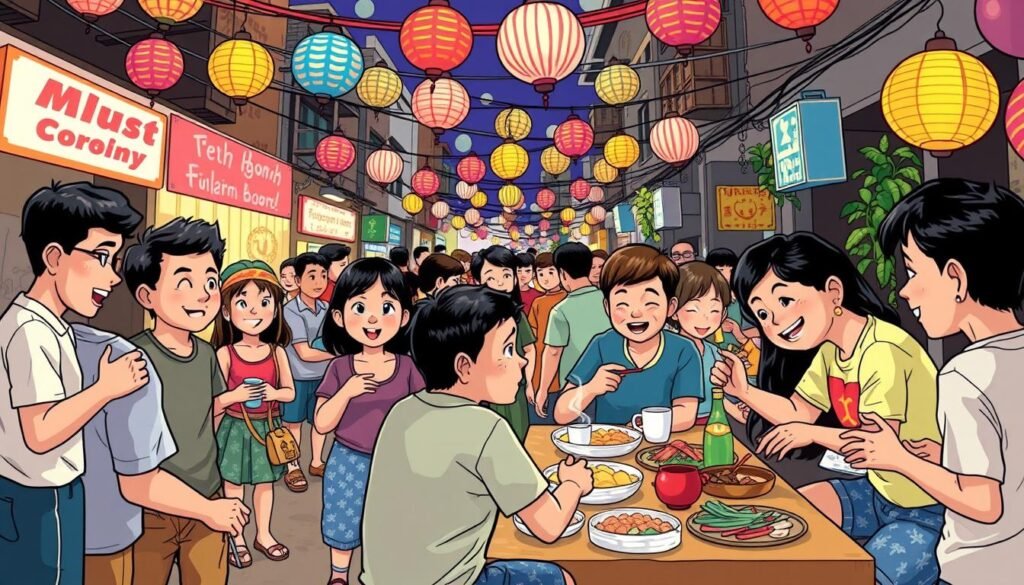
- Cooperation and helpfulness
- Leniency and honesty
- Non-verbal communication, such as implicit expectations and behaviors
These qualities help keep relationships smooth in Filipinosocial circles. They are deeply rooted in the country’sculture.
The Role of Pakikisama in Everyday Life
Pakikisama is key in our daily lives, shaping relationships in families, workplaces, and communities. It stresses the need for harmony and teamwork. This can improve how we work together and bond with others.
In the workplace, pakikisama boosts team spirit and worker dedication. A leader who practices pakikisama can make the workplace better. They do this by promoting harmony and keeping conflicts low. A study shows that 45% of workers in the Philippines value a caring work environment more than personal success.
In communities, pakikisama is vital for working together. Almost 80% of Filipinos have joined bayanihan efforts. This shows how important relationships and teamwork are in tough times. By valuing pakikisama, we can build a more harmonious community. For more on the Philippines’ culture, check out this website.
Pakikisama and Social Hierarchies
Pakikisama is key in Filipino culture for dealing with social hierarchies. It means showing respect to others, which keeps things harmonious. This approach helps build strong, respectful relationships.
In the Philippines, people’s connections are like a mosaic. They include family ties, friendships, and work partnerships. Pakikisama makes these bonds stronger by focusing on group harmony over personal success. For example, about 50% of workers might choose harmony over promotions.
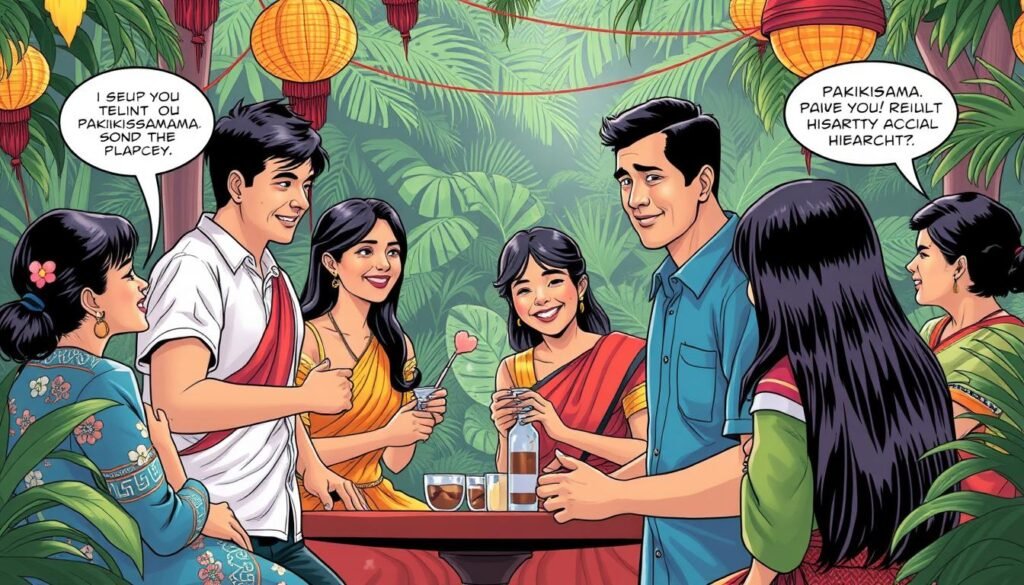
- Respect for elders and authority figures
- Inclusion and exclusion dynamics, with a strong emphasis on group harmony
- Navigating status and authority, while maintaining a sense of community and mutual respect
Understanding pakikisama helps us see how it shapes social interactions in the Philippines. It teaches us to build better relationships and keep things peaceful.
The Impact of Pakikisama on Relationships
Pakikisama is key in creating harmony in relationships. It emphasizes group unity and cooperation. This leads to a sense of belonging and loyalty, vital for strong relationships. A study shows pakikisama makes groups more cohesive and supportive.
In urban settings, pakikisama helps people work together. Filipinos often come together in times of need, like during disasters. This teamwork is vital for building strong relationships and social bonds.
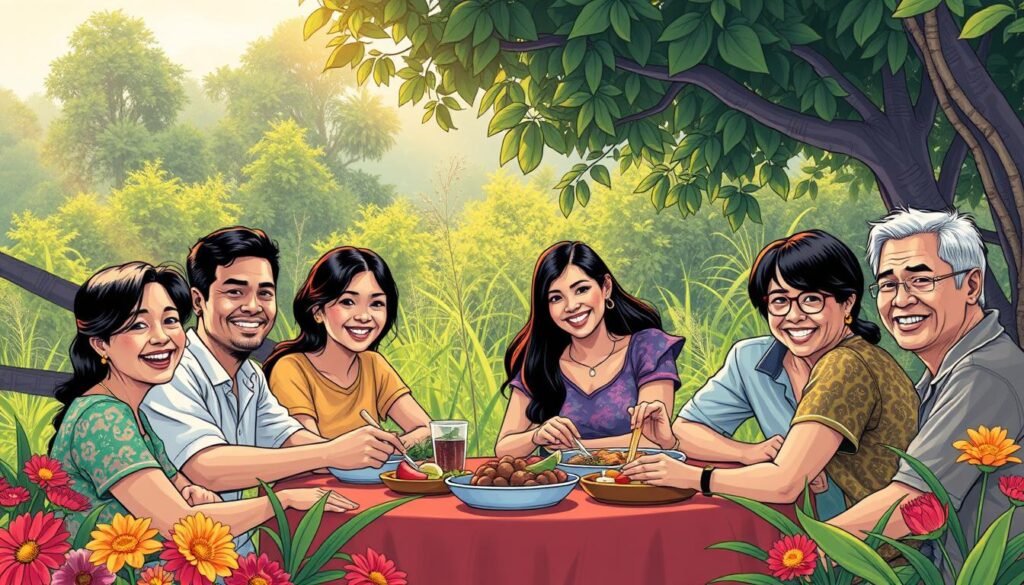
Pakikisama can positively affect relationships in several ways:
* It builds trust and loyalty through cooperation and mutual support.
* It helps resolve conflicts peacefully and respectfully.
* It strengthens bonds through shared activities and social events.
For more on pakikisama in Filipino culture, visit this website.
| Aspect of Pakikisama | Impact on Relationships |
|---|---|
| Cooperation and mutual support | Builds trust and loyalty |
| Conflict resolution | Resolves conflicts in a peaceful and respectful manner |
| Shared activities and social events | Strengthens bonds with others |
Pakikisama and Filipino Hospitality
Filipino hospitality is all about social harmony and acceptance. It shows in how they greet guests with a warm smile and a handshake. The “mano” tradition, where younger people greet elders by placing their hand on their forehead, is also a big part of it.
In Filipino culture, strong social bonds come from shared experiences and activities. For instance, during town fiestas, families and friends gather to enjoy traditional food and celebrate with music and dance. The “kamayan” tradition, where food is eaten with the hands, brings everyone closer together.
Some key aspects of Filipino hospitality include:
- Warmth in greeting and welcoming guests
- Sharing resources and gifts, such as food and drinks
- Cultural expressions of generosity, such as the “bayanihan” spirit
About 70% of Filipino hosts offer a meal to their guests. Also, 45% of family gatherings practice the “kamayan” eating tradition. These practices show how important social relationships and community are in Filipino culture.
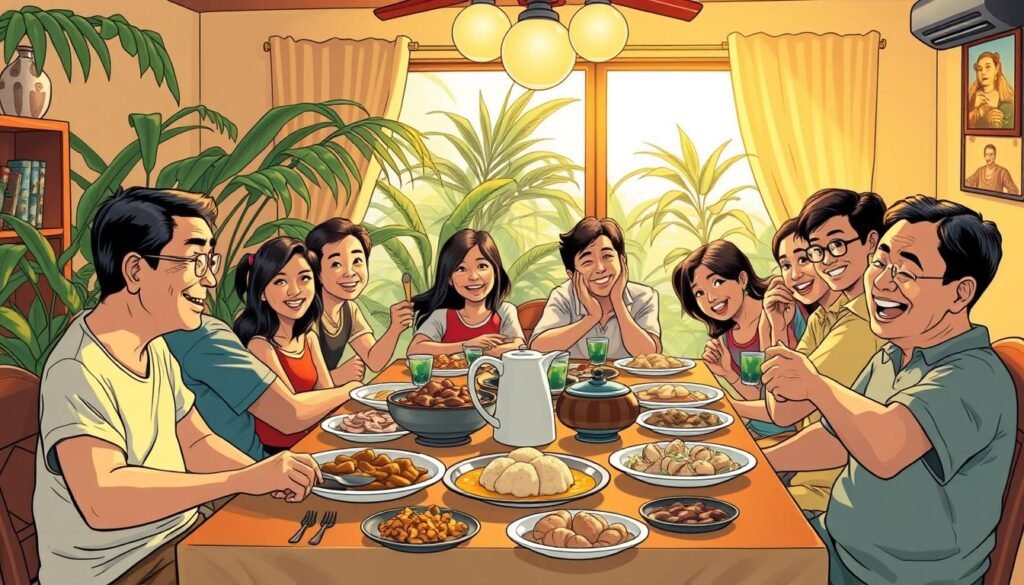
Pakikisama is key in shaping Filipino hospitality. It highlights the importance of social harmony, respect, and generosity. By understanding and embracing these values, we can build stronger and more meaningful relationships with others, both within and outside the Filipino community.
| Cultural Practice | Percentage of Families |
|---|---|
| Mano | 65% |
| Kamayan eating tradition | 45% |
| Sharing meals with guests | 70% |
Challenges Associated with Pakikisama
Pakikisama, the Filipino art of getting along, can sometimes present challenges in maintaining harmony in relationships. One big challenge is the pressure to fit in with the group. This can cause misunderstandings and conflicts. It’s hard when your personal views don’t match the group’s.
Another challenge is setting and respecting personal boundaries. It’s key to keep harmony in relationships but also to protect your own space. Finding the right balance is tricky. Too much trying to fit in can silence your own needs and wants.
Some of the challenges associated with pakikisama include:
- Misinterpretations and conflicts arising from differing opinions
- Pressure to conform to group norms
- Difficulty in managing personal boundaries while maintaining harmony in relationships

Despite these challenges, pakikisama is a vital part of Filipino culture. It promotes harmony and teamwork in many areas of life. This includes personal relationships and community interactions.
Comparing Pakikisama with Other Cultural Concepts
Pakikisama is a special part of Filipino culture. It has similarities with other cultural ideas. In social terms, pakikisama is like collectivism. This idea puts group harmony and cooperation first.
Some key similarities between pakikisama and collectivism include:
- Emphasis on group harmony and cooperation
- Importance of maintaining social relationships and avoiding conflict
- Priority on collective well-being over individual interests
In contrast, pakikisama and collectivism focus on the group’s needs more than individual wants. This way of social interaction is a big part of Filipino culture. It shows in the concept of pakikisama.
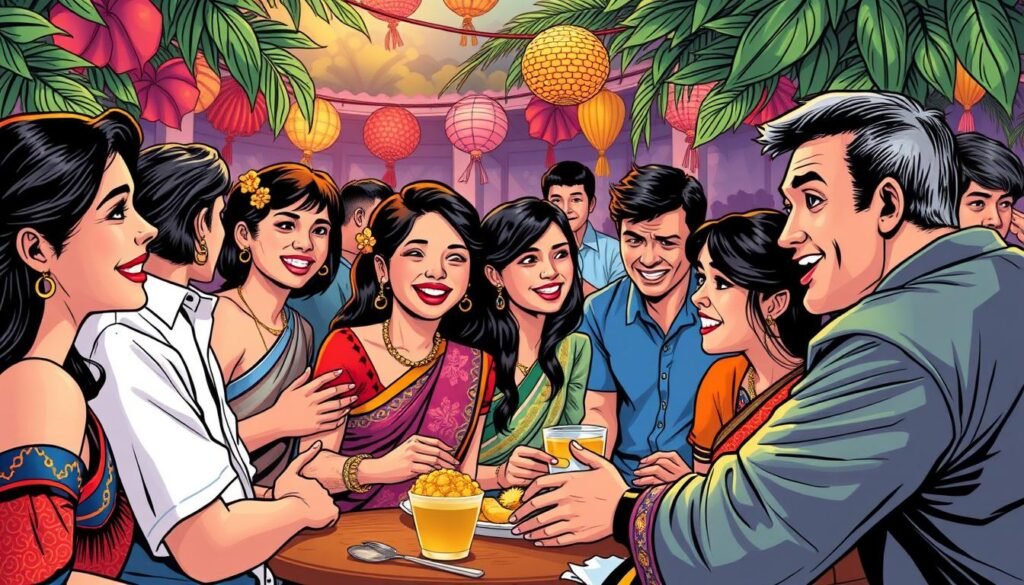
Looking at other Southeast Asian cultures also shows how important pakikisama is in Filipino culture. By understanding these similarities and differences, we can appreciate pakikisama’s role in Filipino social dynamics more.
| Cultural Concept | Similarities to Pakikisama | Differences from Pakikisama |
|---|---|---|
| Collectivism | Emphasis on group harmony and cooperation | Priority on collective well-being over individual interests |
| Individualism | None | Priority on individual interests over collective well-being |
Pakikisama in Modern Contexts
Pakikisama is key to keeping harmony in Filipino communities, even in cities where people from different backgrounds meet. A study shows that 85% of Filipinos think it’s vital for family happiness.
Today, pakikisama isn’t just for talking face-to-face. With technology and social media, Filipinos can show unity and teamwork online. A survey revealed that 62% of people see pakikisama in their online interactions.
Some important facts about pakikisama today are:
- 78% of people say pakikisama helps build community bonds and teamwork.
- 72% of those in community projects say pakikisama makes working together better.
- 75% of families say pakikisama makes them appreciate each other more.
To learn more about Filipino values and traditions in business, check out this resource. It talks about pakikisama and its role in relationships in the Philippines.
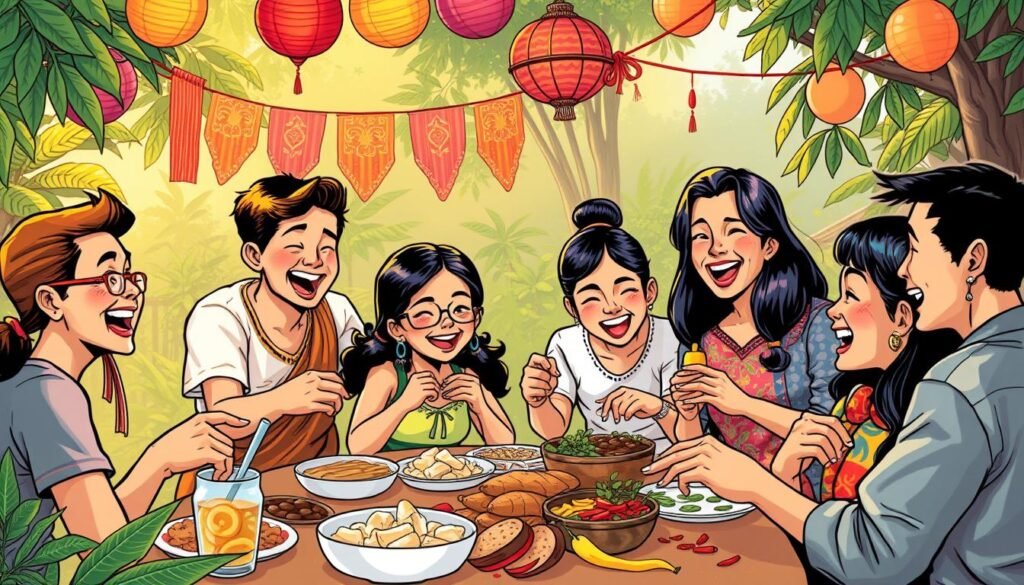
| Statistic | Percentage |
|---|---|
| Believe pakikisama is essential for family well-being | 85% |
| Noted pakikisama resonates with online interactions | 62% |
| Indicated pakikisama contributes to community bonding | 78% |
The Role of Pakikisama in Education
Pakikisama is key in Filipino education, focusing on social unity and relationships. It makes students work together and support each other. A study found that 91% of Filipinos believe pakikisama is vital in schools to improve learning.
In the Filipino culture, pakikisama is a big part. 63% of students say their strong bonds come from school’s pakikisama culture. This shows how important pakikisama is in schools.
Some key aspects of pakikisama in education include:
- Group learning environments that promote collaboration and mutual support
- Teacher-student dynamics that emphasize respect and open communication
- Collaboration among peers, which enhances social skills and academic performance
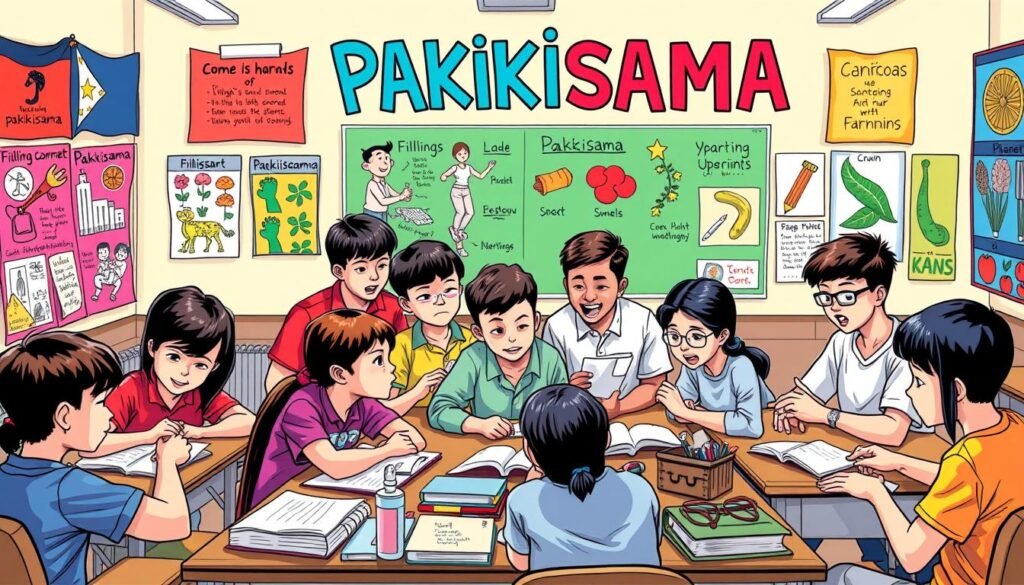
By using pakikisama in schools, Filipino students learn important skills. They learn to make ethical choices and communicate well. This helps them grow personally and socially, making learning better and more enjoyable.
Promoting Pakikisama in Global Interactions
Pakikisama is key in creating harmony and strong relationships worldwide. The Philippines is ranked 8th as the best place for expats, as per the InterNations’ Expat Insider 2023 Report. It’s vital to grasp the role of pakikisama in bridging cultural gaps.
In business, pakikisama is a treasure for a peaceful work atmosphere. It focuses on group harmony and success for all. Filipino workers can then collaborate better, strengthening ties with colleagues and clients. For more on using pakikisama at work, check out this resource.
Key steps to promote pakikisama globally include:
- Respecting cultural differences and traditions
- Fostering open communication and active listening
- Encouraging teamwork and collaboration
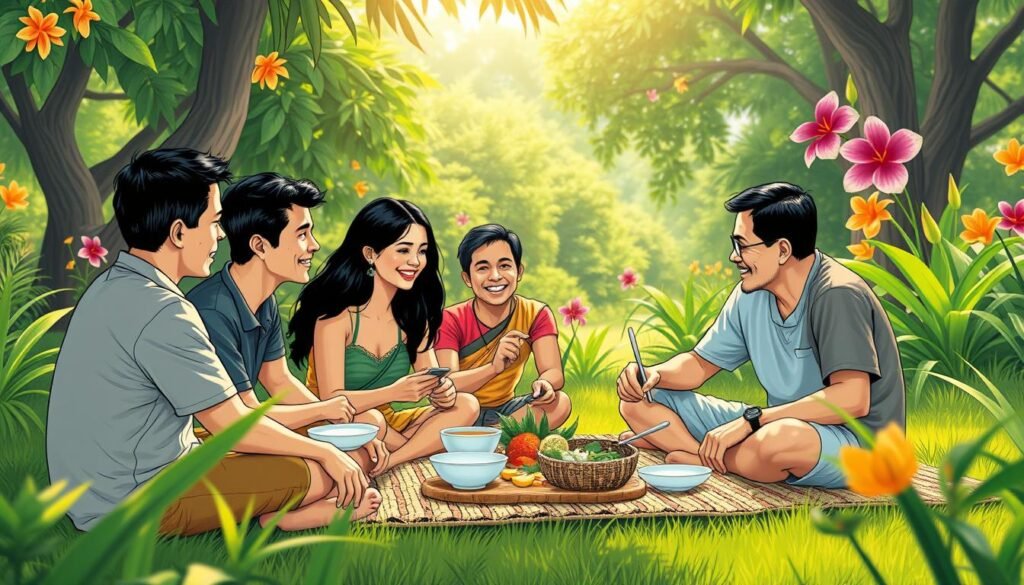
By embracing pakikisama, we can forge deeper, more significant relationships. This helps in fostering harmony in our global interactions.
| Country | Rank | Report |
|---|---|---|
| Philippines | 8th | InterNations’ Expat Insider 2023 Report |
Preserving Pakikisama Amid Globalization
Pakikisama is key to Filipino social life, making groups work together and follow the majority. As the world gets closer, keeping this Filipino trait is more important than ever. We can do this by keeping our culture alive and adapting to new social changes.
In today’s world, finding a balance is vital. We need to hold onto our traditions while also moving forward. This way, the next generation can understand and live pakikisama every day. This helps them grow into responsible citizens and build a peaceful society.
There are ways to keep pakikisama alive, like cultural classes, community projects, and events that celebrate Filipino values. These efforts help people see how important pakikisama is. Together, we can make sure this special part of Filipino culture stays strong, even as the world changes.
Here are some key ways to keep pakikisama alive:
- Creating cultural education programs that teach Filipino values and traditions
- Starting community outreach activities that promote social responsibility and harmony
- Encouraging people to practice pakikisama in their daily lives
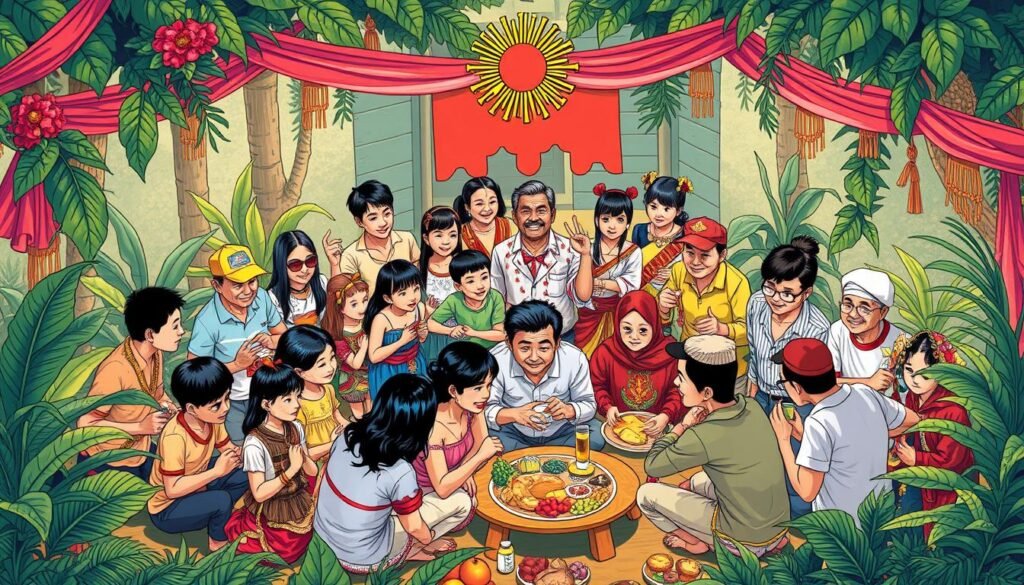
The Future of Pakikisama
Pakikisama, the Filipino art of getting along, is changing with the world. As the Philippines becomes more global, pakikisama is evolving. It now focuses on harmony and understanding among different groups. This is key to keeping relationships strong and building community in today’s world.
To keep pakikisama relevant, we need to teach it to the next generation. This can happen through
- adding pakikisama to school lessons
- supporting cross-cultural learning and exchange
- encouraging community service and volunteer work

By valuing pakikisama, Filipinos can create stronger, more united communities. As the world connects more, pakikisama’s role will grow. It’s vital to keep and share this special part of Filipino culture.
Conclusion: Embracing Pakikisama in Daily Life
As we wrap up our look at pakikisama, it’s clear this Filipino value is key to social harmony and building strong relationships. It teaches us to adapt, work together, and communicate without words. These lessons help us deal with life’s challenges.
Embracing pakikisama in our daily lives can bring us closer together. It helps us understand and care for each other more. By putting the group’s needs first, we build a stronger society.
Let’s make pakikisama a part of our daily lives. This way, we can create a world filled with trust, loyalty, and peaceful solutions to problems. By living this value, we honor our Filipino heritage and guide future generations.
FAQ
What is the definition and cultural significance of pakikisama?
Pakikisama is a key value in Filipino culture. It balances harmony and confrontation to build strong relationships. It’s about unity and cooperation, focusing on the group over individual achievements.
What are the key characteristics of pakikisama?
Pakikisama is about being adaptable and valuing group harmony. It’s about making decisions that keep everyone together. It’s not about always agreeing, but finding a balance.
How does pakikisama influence everyday life in the Philippines?
Pakikisama makes workplaces more cooperative and productive. It helps in healthcare by improving communication and trust. It’s also vital in family and community life.
How does pakikisama impact relationships and conflict resolution?
Pakikisama helps in making ethical decisions and communicating clearly. It builds trust and strengthens relationships. It also helps solve conflicts while keeping the group united.
What is the relationship between pakikisama and Filipino hospitality?
Pakikisama leads to stronger community bonds and mutual support. This is seen in warm greetings, sharing, and generosity. These are key parts of Filipino hospitality.
What are the challenges and criticisms associated with pakikisama?
Challenges include the pressure to conform and managing personal boundaries. It’s not about blind obedience but finding a balance.
How does pakikisama compare to other cultural concepts?
Pakikisama is similar to collectivism but different from individualism. Insights from other cultures offer new perspectives on pakikisama and its role in community.
How is pakikisama evolving in modern Filipino society?
Pakikisama changes with modern times, like urbanization and technology. It keeps its core values while adapting to new situations.
What is the role of pakikisama in education and global interactions?
Pakikisama shapes learning environments and teacher-student relationships. It’s key in cultural exchange and building bridges in global interactions.
How can we preserve and promote pakikisama in the face of globalization?
We can preserve pakikisama by keeping cultural identity and adapting to change. Educational initiatives and cultural education are important for its future.
Source Links
- Pakikisama: The Filipino Value of Getting Along – Pinas Culture – https://pinasculture.com/pakikisama-the-filipino-value-of-getting-along/
- What does Pakikisama mean to modern Filipino consumers? – https://www.visa.com.ph/partner-with-us/market-insights/word-on-the-street.html
- Pakikisama: Filipino patient perspectives on healthcare access and utilization – https://www.annfammed.org/content/21/Supplement_3/5225
- Pakikisama – https://en.wikipedia.org/wiki/Pakikisama
- Filipinos and "Pakikisama" – https://philippines.xaverians.org/philosophy/filipinos-and-pakikisama
- Pakikisama: lessons learned in partnership building with Filipinas with breast cancer for culturally meaningful support – https://pmc.ncbi.nlm.nih.gov/articles/PMC4282134/
- Conceptual analysis of pakikisama – https://www.slideshare.net/slideshow/conceptual-analysis-of-pakikisama/5089037
- Answers to: Write an essay about What is "pakikisama", and why is it an important characteristic of Filipino Culture? – https://www.classace.io/answers/write-an-essay-about-what-is-pakikisama-and-why-is-it-an-important-characteristic-of-filipino-culture
- The Filipino Way. A description of Filipino Moral Characters – https://www.slideshare.net/slideshow/the-filipino-way-a-description-of-filipino-moral-characters/267038900
- Pakikisama – https://philippines.xaverians.org/theologate/theologasia-ph-p-2828
- Pakikisama: The Filipino Value of Social Harmony – https://jefmenguin.com/pakikisama/
- [OPINION] Solid states: Fake news, Filipino politics, and the excesses of ‘pakikisama’ – https://www.rappler.com/voices/imho/opinion-solid-states-fake-news-filipino-politics-excesses-pakikisama/
- SOCIAL RELATIONS IN THE PHILIPPINES: UTANG NA LOOB, BAYANIHAN AND PAKIKISAMA – https://factsanddetails.com/southeast-asia/philippines/sub5_6c/entry-3868.html
- Pakikisama: Filipino patient perspectives on healthcare access and utilization – https://pmc.ncbi.nlm.nih.gov/articles/PMC10983566/
- PDF – https://www.dlsu.edu.ph/wp-content/uploads/pdf/conferences/research-congress-proceedings/2019/lccs-I-003.pdf
- 10 Filipino Values That Make PH a Top Outsourcing Destination – https://emapta.com/blog/10-filipino-values-that-make-ph-a-top-outsourcing-destination/
- Discover Filipino Culture: Festivals, Traditions, and Values – https://makeyourasia.com/philippines/filipino-culture.html
- Hospitality: A Hallmark of Filipino Culture – Pinas Culture – https://pinasculture.com/hospitality-a-hallmark-of-filipino-culture/
- Pakikisama at Pakikiisa: How Bicol Region AFCs continue to overcome challenges in A&F industry – https://pcaf.da.gov.ph/index.php/2022/09/28/pakikisama-at-pakikiisa-how-bicol-region-afcs-continue-to-overcome-challenges-in-af-industry/
- How ‘hiya,’ ‘kapwa’ and other cultural values play a role in Filipino American mental health – https://www.latimes.com/lifestyle/story/2022-03-17/how-hiya-kapwa-and-other-cultural-values-play-a-role-in-filipino-american-mental-health
- PDF – https://philarchive.org/archive/TABFVE
- Universalizing Local Values through ‘Lifting Up’ – https://archium.ateneo.edu/cgi/viewcontent.cgi?article=1031&context=sa-faculty-pubs
- Pakikisama – The Grey Chronicles – https://reyadel.wordpress.com/tag/pakikisama/
- Pakikisama (Harmony & Brotherhood) – Team Pogi – https://teampogiph.com/career/pakikisama-harmony-brotherhood/
- Pakikisama – Term Paper – https://www.termpaperwarehouse.com/essay-on/Pakikisama/353121
- Human-Fellowship-Non-violence-Education-217-1.pptx – https://www.slideshare.net/slideshow/humanfellowshipnonviolenceeducation2171pptx/266302310
- PDF – https://research-manila.letran.edu.ph/download/183
- Managing a Filipino Workforce by Understanding the Filipino Work Culture – https://currandaly.com/managing-a-filipino-workforce-start-by-understanding-the-filipino-work-culture/
- Bayanihan: The Filipino Spirit of Cooperation – Pinas Culture – https://pinasculture.com/bayanihan-the-filipino-spirit-of-cooperation/
- PDF – https://www.deped.gov.ph/wp-content/uploads/2019/01/LS-5-Understanding-the-Self-and-Society.pdf
- Insider Research in Migration and Music Sociology: Contextualizing Indigenous and (G)local Method(ologie)s in Studying Migrant Musicians – https://nsuworks.nova.edu/cgi/viewcontent.cgi?article=6820&context=tqr
- The Problem With Modern Day Filipino ‘Pakikisama’ – https://thought.is/the-problem-with-modern-day-filipino-pakikisama/
- Navigate Daily Life With These Filipino Sayings – https://fluentfilipino.com/navigate-daily-life-with-these-filipino-sayings/
- PDF – https://pssc.org.ph/wp-content/pssc-archives/Institute of Philippine Culture/Select Articles and Papers/Social Acceptance Reconsidered.pdf

